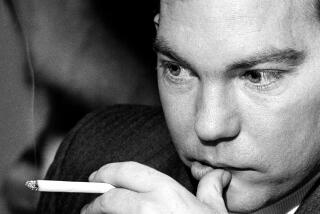Ron Ridenhour; Exposed My Lai Massacre
- Share via
NEW ORLEANS — Ronald L. Ridenhour, an infantryman-turned-journalist who seared the world’s conscience with the first public account of the slaughter of 500 Vietnamese villagers at My Lai, has died. He was 52.
Ridenhour died of a heart attack Sunday while playing handball in the suburb of Metairie, his friend, Mary Howell, said.
Although Ridenhour spent decades as an investigative reporter after leaving Vietnam, he was best known for exposing the events surrounding the My Lai massacre on March 16, 1968.
The massacre, which led to the court-martial of Lt. William Calley and five other soldiers, stands as one of the worst moments in U.S. military history.
Ridenhour was a door gunner on an observation helicopter that flew over the village a few days after the killings. He heard about the incident from other soldiers and talked to enough people to become convinced that a massacre had occurred.
Three months after he returned home in December 1968, Ridenhour typed up what he had learned in a three-page, single-spaced letter and sent off 30 copies to Arizona’s congressional delegation and other federal officials.
His letter describing the annihilation of My Lai--a place the soldiers called “Pinkville”--was unsparing.
He wrote of a soldier who found a 3- or 4-year-old boy trying to stop the bleeding in his wounded arm. Instead of helping the child, the soldier killed him with a round from his M-16.
Another soldier shot himself in the foot so he wouldn’t have to participate in the slaughter, Ridenhour wrote.
Paul Meadlo, a rifleman, said that as he stood guard over about 80 villagers, Calley ordered, “Waste them!” The two men then emptied four or five clips of ammunition into their helpless captives, Ridenhour wrote.
“I am convinced that it was something very black indeed,” he wrote.
Reporters soon took notice of Ridenhour’s account. In 1969, journalist Seymour Hersh won the Pulitzer Prize for his expose of the massacre.
Although an official probe led to war crime charges against 13 officers and enlisted men, Calley was the only one convicted. He was sentenced to life in prison but served only three days because President Richard Nixon ordered his sentence reduced. Calley then spent three years under house arrest.
Born in Oakland and reared in Arizona, Ridenhour attended Phoenix College before he was drafted. After his discharge, he studied literature at Claremont Men’s College, where he played defensive tackle on the Claremont-Harvey Mudd football team.
“There’s just no angle,” he said in explaining his whistle-blowing actions to The Times in 1969. “This was just wrong. . . . Doesn’t the whole incident strike you as rather appalling, something that should be brought to justice? It’s just not nice to murder people.”
Ridenhour, as a New Orleans-based writer, contributed book reviews and opinion pieces to The Times. On the 25th anniversary in 1993, he reflected in an Op-Ed page article on disappointing lessons he gained from My Lai: “Some people--most it seems--will, under some circumstances, do anything someone in authority tells them to. Another is that government institutions, like most humans, have a reflexive reaction to the exposure of internal corruption and wrongdoing: No matter how transparent the effort, their first response is to lie, conceal and cover up.”
In 1988, Ridenhour won a Polk Award for local reporting for a story he wrote in New Orleans City Business about his yearlong investigation of a city tax scandal.
More to Read
Sign up for Essential California
The most important California stories and recommendations in your inbox every morning.
You may occasionally receive promotional content from the Los Angeles Times.













